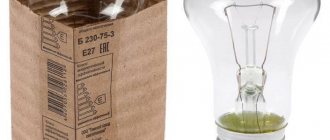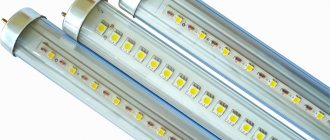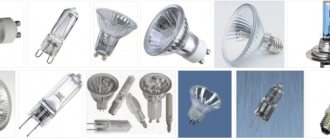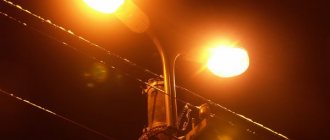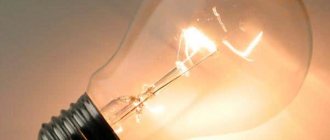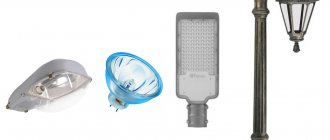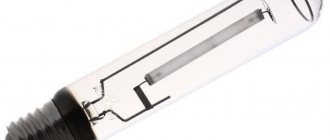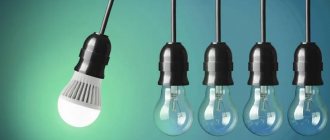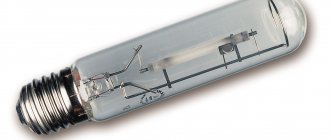Well, guys, it’s time to talk about the next type of base, namely the E14 modification. We talked about E27 in this article . This smaller version is now very widely used in various bot devices and equipment. I must say thank you to LED technology; it is their use in lighting that practically eliminates the importance of the size of the base. However, today we will talk specifically about E14, so if you are looking for information, read it, you won’t regret it...
First, a little definition
base (or ES in the USA and Europe) is the younger brother of the E27, appeared much later and was designed for small lighting fixtures and chandeliers. It got its name because of the size - 14 is the diameter in millimeters, but the letter “E” denotes the screw type (invented by Edison - Edison Screw).
As a rule, incandescent lamps with such an “end” were not powerful, the maximum versions reached only 40 watts and were used in various household appliances, such as refrigerators, stoves, etc. It was also widely used in all kinds of lamps and chandeliers . Often, in order to achieve a normal level of illumination, at least 6 and at most 18 pieces were placed in a chandelier. They were often combined with the “E27”
Features and Specifications
E14 bulbs are the most common along with E27. They are suitable for most types of miniature lamps, and the price of lamps varies from 10 to 20 rubles.
The devices are easy to operate, do not cause difficulties when replacing the cartridge, and consumption is low. Designed to work with a voltage of 220 Volts.
There are LED analogues that use the E14 socket. They are not very powerful, but the level of luminous flux is higher than for sources with filament. E14 diode bulbs are compact, so they are used even for recessed luminaires.
Compatibility of “minions” with lighting devices
Quite often it happens that the base of an E14 light bulb does not fit a particular socket. If the value is sensitive, it is irrational to throw them away or leave them collecting dust in the pantry. The solution would be to purchase an adapter. Such adapters are inexpensive and allow you to install, for example, an E14 lamp in an E27 socket or vice versa. There are many modifications of adapters for various standard sizes.
Many craftsmen independently solder the bases from one emitter to another. But such actions are justified only if there is interest in such work and free time. In other cases, it’s easier to go to the nearest electrical goods store.
What types of lamps are there with this type of base and where are they used: features and parameters
E14 socket is used in incandescent, fluorescent, halogen and LED lamps. All of them are used in lighting devices, for illuminating refrigerators or microwave ovens. Bulbs of different types of E14 base will differ in size - products with incandescent filament are the smallest. Therefore, when purchasing devices, you should understand that they will look different in a chandelier.
The E14 also differs in shape. The most common type of light bulb is the “Candle”, which is used in ceiling chandeliers. Products in the shape of “Candle in the Wind” are installed in sconces - the top of the bulb is slightly elongated and curved.
“Fire flames” are more expensive and less popular forms of light bulbs. According to the manufacturer's idea, the bulb should be visible, so it makes no sense to use it in lighting fixtures with a lampshade.
The most common forms of "minions"
The appearance of the lamp when installed in an outdoor fixture can be very important. An incorrectly chosen shape will ruin the interior even with the most beautiful chandelier. The most versatile lamp with an E14 base is the “candle”, used in ceiling chandeliers. For a sconce or night light, a good choice would be to purchase shapes such as “candle in the wind.” It differs from the previous version with an elongated “tail” and a slightly curved top of the flask. The third common form of such emitters is the “twisted candle”. Its bulb has pronounced spiral structural stripes.
A slightly less popular form due to its higher cost can be called “fire flame”. The use of such emitters in lamps with a shade is irrational - the bulb must be completely visible in order for the effect intended by the manufacturer to be realized.
For ordinary closed lamps, the cheapest shape options are used - “pear”, “elongated ball”, “ellipsoid”. For household appliances (refrigerators, microwave ovens, ovens), lamps narrowed to the base are used, and for spotlights, a “parabolic reflector” is suitable. In total there are 13 main forms.
Advantages and disadvantages of use
The main advantages of light bulbs with E14 base:
- mass production of the product;
- low cost of products with filament;
- suitable for almost all lamps;
- low energy consumption (about 40 W);
- variety of forms;
- E14 base is used in all types of lamps - fluorescent, incandescent, LED, halogen, energy-saving analogues.
Flaws:
- The maximum power is only 60 W.
Separately, it is worth considering LED devices, because it is to them that the active transition occurs.
Advantages of diode light bulbs:
- low energy consumption compared to incandescent lamps;
- standard service life is 4-5 years;
- absence of harmful components in the composition;
- ease of disposal;
- the ability to repair devices if they break down;
- do not warm up;
- they are stronger than fragile incandescent lamps;
- wide range of color temperatures.
Minuses:
- to organize bright lighting, many light bulbs are required due to their low light output;
- high price;
- there are a large number of fakes on the market that do not meet the stated requirements;
- excess temperature is dangerous for the operation of diodes;
- The size of LED lamps is larger than conventional ones.
Important! Since LED lamps do not heat up, they can be used to organize lighting on suspended ceilings.
TOP 5 manufacturers and models of lamps
The lighting technology market is full of various solutions and modifications of lighting sources. According to statistics, over the past year five brands have made it into the TOP of the best manufacturers. Products were evaluated based on technological content, functionality, and compliance with declared and actual characteristics.
Budget-friendly and reliable Canyon devices
The European company Canyon produces high-quality German-made lighting fixtures with standard bases suitable for various modifications of lighting equipment.
Consumers highlight the relatively low price as the main advantage of Canyon LED lamps. The disadvantages include insufficiently careful assembly and periodic pulsation during voltage surges
The presented models of the brand are manufactured according to the latest international requirements.
They are united by several advantages:
- a large selection of products in a different range of color temperatures;
- low heating level - only 80°, while the indicators of similar devices from other companies are 90-110°;
- the use of Chip On Board technology, which comprehensively protects internal elements from harmful external influences;
- five year warranty.
When testing the glow strength, users detected about 10% of the consumption with the declared indicators, which, taking into account the small measurement error, is not so critical.
One of the popular Canyon models with a 14 mm base is the matte LED B38 candle lamp, designed to consume 6 W of power, equivalent to 40 W of an ordinary lamp. Its light output is 470 lumens.
The Canyon lamp diffuses warm white light throughout the room and provides good color rendition. Unique Cob Ice module prevents overheating and maintains operational safety
The elegant design allows the device to be used in a variety of open chandelier models. Experts recommend installing a candle-shaped light bulb with the bulb facing up.
Innovative X-Flash light sources
X-Flash brand belongs to a Russian company that develops LED equipment for household, commercial and industrial use. During its short existence, it managed to become a successful player in the lighting technology market.
The brand’s laboratory produces powerful devices with advanced technical characteristics.
Thanks to continuous improvement, the company's LED lamps are endowed with a number of advantages:
- emission of comfortable light without flickering;
- high light output;
- stability of luminous flux parameters;
- extensive range;
- long service life.
The company's real hit of sales, which has exploded the market, are smart lamps, which are heavy-duty models for illuminating industrial facilities. They have built-in special photoresistors and motion sensors, making it possible to automate switching.
Not long ago, a particularly successful updated X-Flash with an E14 base was released. The luminous intensity indicators in it significantly exceed the limits established for products with a similar threaded connection. They amount to 820 Lumens.
In its new development, the X-Flash manufacturer managed to realize almost impossible technical characteristics, bypassing the limitations associated with the design features of a small base
The device has an elongated rectangular shape and shines 2-3 times better than its competitors. The color temperature falls between daytime white and warm tones.
The manufacturer provides a 5-year warranty and states that the light bulb can function properly for at least 43 thousand hours. Testing has shown that the promised parameters coincide with actual performance.
Inexpensive and high-quality Feron devices
Feron company has a reputation as a long-liver of the Russian lighting equipment market. It stands out for its affordable pricing policy and honest technical characteristics.
The company’s assortment includes more than 4 thousand items, which deserve trust due to the following nuances:
- intense and bright light;
- high-quality assembly;
- increased energy efficiency class;
- reliable electronic components;
- IC driver that protects against power surges.
Among the range of Feron lamps, the spherical model with 14 bases from the SAFFIT - SBG4507 . It has strong parameters - a power of 7 W and a light flux of 560 Lm. The light bulb produces a comfortable white light, close to the natural shade.
The brightness of the Feron SAFFIT light bulb exceeds the values of similar models by 15%. Matte diffuser softens harsh light rays, distributing light evenly throughout the room
The model ripples due to voltage drops are excluded. Subject to operating conditions, the lamp will operate for about 30 thousand hours.
The manufacturer provides a three-year warranty period for it. Most often, this modification is installed in recessed spotlights.
Safe and technological solutions Era
The domestic brand “Era” has been producing electrical products for the second decade. The main motto of the production is the use of modern technological principles, suggesting improved safety and increased energy savings.
Among the advantages of Era LED devices:
- large radiation angle;
- good color rendering;
- long service life;
- robust design.
As for the disadvantages, many consumers complain that the manufacturer slightly overestimates the power equivalent in relation to devices with filaments.
The brand's best seller is a model with an E14 LED smd R50 base from the ECO series. Its continuous service life is about 25 thousand hours. The product shines with a soft warm light. Light output power – 420 lumens
In general, the parameters correspond to the characteristics of products with incandescent filament, equipped with a power of 40 W. fulfills warranty obligations in case of product failure within one year from the date of sale.
Jazzway universal products
The well-known company JAZZWAY produces reliable LED products in more than 1,500 positions. The assortment includes all types of lighting solutions, divided into categories: economy, standard, combi.
During production, the brand conducts independent examinations and effective multi-stage quality control.
As a result, you receive certified JAZZWAY products with many advantages:
- long service life;
- good color rendering;
- safe and durable packaging;
- emit flicker-free, even light.
, the PLED-ECO-C37 model deserves attention , producing natural white lighting. Normal operation of the device is maintained within the temperature range from -20° to +40°.
With a power of 5 W, the luminous flux of the bulb is 300 lumens. The design of the product body consists of durable plastic materials
Its dispersion angle is average – 190°. Analyzing consumer reviews, it becomes clear that this model rarely breaks down. If any problems do arise, a two-year manufacturer's warranty is provided in this case.
Marking
The sockets are marked as follows - first there is a letter, then 2 numbers. The following types exist:
- B – pin;
- E – threaded, also called Edison base;
- G – pin;
- R – with recessed contacts;
- P – with focusing contacts;
- S – soffit;
- T – telephone connection;
- K – cable connection;
- W – baseless.
The number is the thread diameter in millimeters. To ensure compatibility, adapters have been created that allow you to install a lamp with an e27 base on an e14. Thanks to special adapters, you can install standard incandescent lamps in a socket with an E14 thread.
Edison base e14
The Edison socket is a screw mechanism that was developed by Thomas Edison specifically for mounting incandescent lamps. Since then they have been produced with threaded bases of different diameters. In the designation, “e” means screw type, and the number is the diameter in mm. E14 is one of the most common household bases in Russia.
Design
Device
Structurally, the base is similar to a cylinder with a thread with a diameter of 14 mm. It is made of aluminum. There is a contact at the top. An electrode is attached to it, which leads to the filament body. The second electrode from the tungsten helix is attached to the thread of the base.
There is a hollow glass insulator inside. It is necessary for pumping out air and pumping inert gases and buffer mixtures into the flask. The insulator is present only in incandescent and halogen lamps. Other types have a similar base design.
It is important to connect the wires to the socket correctly. If an error occurs, there is a risk of electric shock to a person. To avoid this, the phase wire is connected to the base contact, and the neutral wire is connected to the screw thread.
Electrical connection
Dimensions
E14 sizes are standard.
Dimensions
Application area
Lamps with “minions” are most often produced for lighting apartments and houses. They are suitable for both local lighting (sconces, wall lamps, table lamps) and general lighting (chandeliers).
In addition, “minions” are produced for illumination in household appliances: refrigerators, etc.
What to consider when choosing an e14 lamp
When choosing a light bulb for a lamp, you need to consider the following important parameters:
- power;
- sizes, shape;
- company manufacturer;
- optimal mains voltage.
When purchasing the product, you should inspect the integrity of the product. If scratches or unreliable contacts are found, such a light bulb cannot be taken.
When choosing an LED device, you need to pay attention to:
- Glow efficiency. This parameter shows how much luminous flux the light bulb produces per 1 watt. The efficiency of diode products ranges from 60 to 80 lm/W.
- Glow power. It can be compared with the indicator of an incandescent lamp using special tables.
- Colorful temperature. The shade of the glow depends on it. It is selected depending on the purpose - for example, when used in a residential area, it is better to give preference to warm colors. For offices, light bulbs are purchased in neutral white shades. Cool colors can be used in industrial areas. Color temperature is measured in Kelvin (K). Warm white shades are in the range of 2700-3500 K, neutral – 3500-4000 K, cold – 5500-6000 K.
- Mains voltage. LED devices operate either from a 220 V network or from a 12 V power source. Devices with socket e14 and e27 can operate on direct and alternating voltage.
- Color rendering index. Measured in the range from 0 to 100. High-quality display of the color gamut is available with an index of 98 and higher. Below 80, color distortion occurs.
- Direction of light, angle of illumination. Depending on the shape, the radiation pattern and, accordingly, the direction of illumination differ.
- Ability to control brightness. This is an additional feature; these lamps have dimmers that allow you to change the brightness.
- Ripple factor. Flickering light negatively affects the eyes and nervous system, so for health safety you should buy products with low pulsation. SNIP recommends purchasing devices with a coefficient of 5-20%. Flickering lamps are usually produced by little-known companies that sell products at low prices.
- Date of manufacture. Models older than two years may be significantly inferior to the latest products in terms of their characteristics.
- Warranty, service life.
LED lighting sources (LED) with E14 socket
LED lamps with E14 socket, like their analogues, are not very powerful. For example, lighting sources with filament have a power of up to 60W, fluorescent - no more than 15W, and for LEDs the maximum level is 7W. Therefore, chandeliers or other ceiling lamps responsible for general lighting have several such lamps.
Despite the low power of LED lamps, the level of luminous flux is greater than that of filament sources or their fluorescent counterparts. Below is a table that shows how different types of parameters affect the radiation intensity.
| Filament lamps (W) | Fluorescent (W) | LED (W) | Luminous flux level (Lm) |
| 20,0 | 5,0-7,0 | 2,0-3,0 | ~250,0 |
| 40,0 | 10,0-13,0 | 4,0-5,0 | ~400,0 |
| 60,0 | 15,0-16,0 | 6,0-10,0 | ~700,0 |
| 75,0 | 18,0-20,0 | 10,0-12,0 | ~900,0 |
| 100,0 | 25,0-30,0 | 12,0-15,0 | ~1200,0 |
| 150,0 | 40,0-50,0 | 18,0-20,0 | ~1800,0 |
| 200,0 | 60,0-80,0 | 25,0-30,0 | ~2500,0 |
As can be seen from the table, an LED lighting source is approximately two to three times more economical than its fluorescent counterpart, and incandescent lamps - six times or more. We do not consider halogen sources, since they are not formally energy-saving.
You should also take into account the disadvantages inherent in fluorescent lighting sources, namely:
- subtle flicker, which causes eye fatigue and can cause nervous irritation;
- The mercury vapor contained in lamps not only significantly increases the risk during operation, but also requires special disposal of the source after its failure.
LED lamps do not have the disadvantages listed above, they do not cause eye irritation and do not contain chemical compounds that are unsafe for humans and the environment.
It should also be noted that LED sources for the E14 base type are quite compact, so they can be installed in almost any lamps, including recessed ones.
LED lamp: a – b – Gauss; b – Osram
As for the shape of LED lamps, it can be varied, for example, the source can be made like a ball or a candle. And given that LED lamps can be colored, this opens up broad prospects for design.
How to choose an LED lamp
In order not to make a mistake with your choice, you need to pay attention to the following points:
- The lamp base must match the type of socket installed in the lighting fixture for which the light source is purchased. Note that adapters are available for E27 and E14 sockets. Do not confuse them with other types, for example, a point source is different in that it uses a different base;
- manufacturer, choose products from well-known manufacturers, for example, Philips, Camelion, Gauss, etc. As practice shows, products from well-known brands last much longer than the Chinese name (from English no name, literally “without a name”);
- when installing LED lamps instead of filament or fluorescent sources, select an analogue with the appropriate luminous flux power, the table for this was given above;
- Considering that most modern LED sources have about 90-100 Lumens per watt of power, it is not difficult to calculate the approximate level of luminous flux. For example, a 220-volt 7W light bulb creates a luminous flux of about 630-700Lm;
- manufacturers do not produce household LED lamps whose efficiency exceeds 130 Lm per 1 W, since such products are unreasonably expensive;
- A high-quality LED lamp should not flicker; if this happens, it means that the control circuit (driver) is not working in normal mode, it is better to refuse to use such a device. Theoretically, the driver can be repaired if you have the necessary components and certain skills;
- frosted bulbs reduce the level of luminous flux by 15 to 30%. If this is critical, then it is better to buy a source with a transparent bulb.
In rooms with low humidity levels, you can install the lamp by first removing the bulb from it (this requires a little force). But remember that in this case you lose the warranty.
Color temperature selection
Color temperature refers to the tone of the luminous flux emitted by a lighting source; it is measured in Kelvin (K). LED lamps are produced in three temperature ranges:
- warm white (from 2000 to 3800K);
- neutral white (from 3800 to 4500K);
- cold white (more than 4800K).
Visually, the difference in color temperature is shown in the figure below.
Color Temperature Difference
According to observations, the most optimal and comfortable temperature for a living space is in the spectrum of warm and natural white light. That is, for a home it is better to select lighting sources in the range from 2800 to 4500K.
Cool white light is installed in public places, as well as to illuminate work areas where moving objects or small parts are used.
Installation of LED lamps with E14 socket
Let's look at the design of LED lamps using the example of a light source produced under the Maxus brand; its structure is shown in the figure.
LED light source design
Designations:
- A – scattering bulb;
- B – light-emitting diode elements;
- C – heat-sinking printed circuit board, used to attach LEDs and remove heat from them to the radiator;
- D – anodized alloy radiator (Maxus lamps use 1070 grade aluminum);
- E – board that powers the LEDs (driver);
- F – polymer insulator;
- G – E14 base.
Scope of application
A person perceives dim sunlight best - in addition to physiological comfort, it can influence the psychological component and facilitate work. The more the light emitted by an artificial source corresponds to natural light (read: solar), the more calm a person feels throughout the day. That is why, when developing the design of an LED lamp with an E14 base, it was decided to focus on natural light, which reduces the overall load and eliminates fatigue.
Lifetime of LED lamps
Manufacturers often indicate the approximate service life of an LED lamp, while mercilessly overestimating it (for example, up to 50 thousand hours). Experienced electricians recommend not to rely entirely on what is indicated on the packaging, since the service life depends on many factors:
For example, reliability and correct assembly in compliance with all technologies play an important role. You should not expect that a Chinese light bulb will serve you for 5 years - most likely, during its production some technical conditions were violated, so it may fail much earlier. To the point that it will burn out immediately after switching on.
High-quality cooling is also very important. During operation, LEDs get quite hot, so most products have cooling radiators. If such a lamp is placed in a closed lampshade, then over time it may begin to lose brightness.
Constant voltage drops can also negatively affect the service life of an LED lamp.
Useful recommendations for choosing
To summarize the review, we can highlight several points that will greatly facilitate the selection of a suitable LED light bulb model with a standard base.
Firstly, the type of socket installed in the lighting equipment must correspond to the size of the base of the lamp being purchased. For sockets E 14 and 27 there are special adapters.
Secondly, additional savings on purchases are not always advisable. Cheap light bulbs sold by unreliable brands often fail. Trusted manufacturers are responsible for the quality of the product and guarantee replacement or repair of the product in case of breakdowns.
Lighting equipment equipped with a matte bulb is ideal for organizing softer and more subdued lighting in a room that does not irritate the eyes. If the room requires a bright light source, it is more advisable to buy LED lamps with a transparent bulb
Thirdly, light sources with filament or fluorescent light bulbs must be correctly replaced with LEDs, selecting a similar luminous flux power. In this case, you can refer to the table above.
Before purchasing, you need to check whether the light bulb is pulsating during operation. Having discovered such a phenomenon, it is advisable to discard the device, since its control circuit is imperfect.
What parts does the cartridge consist of?
It is a prefabricated structure consisting of several parts. Inside the housing there is also a core, a screw-type clamp, a clamping contact and a thread through which the light bulb is screwed.
Core
For its production, ceramics, plastic or carbolite are usually used. These materials allow the lamps to work, but at the same time, electricity costs remain minimal. Depending on the design of the cartridge, the dimensions of the core and its shape may vary.
Screw clamp
Its main function is to ensure the connection of conductor and terminal parts. They are found in lamps marked O, U, C. In the design of new models, the terminals can be located outside.
Pressure contact
The pressure contact is the contact that is pressed against the metal or semiconductor. It is made from brass. Some products may have two or four plug-in contacts, while in others their function is performed by one spiral.
Thread
It is a necessary element in the design, but can also be different. There are threads designed specifically for use in industrial premises, and there are also household options. There are also models for outdoor installation; they are not afraid of snow, rain and are able to work in difficult conditions.
Frame
Modern models of cartridge cases are made of ceramics. This material can withstand high temperatures without melting, deforming or breaking. Also, modern versions have a non-separable design with built-in threads.
Pin models
Contact of the lamp with the socket is carried out due to the pins entering its holes. The numbers after the letter G indicate the distance between the two contacts. If the number of such contact elements is more than two, then the marking indicates the base diameter.
The G4 socket is used in small halogen lamps, which create an unusual decorative effect in the form of a bright point source of light on ceilings. These bulbs are used at a voltage of 24 or 12 volts, which is very convenient when used in flexible lighting systems, as well as in luminaires built into the ceiling. The service life of such devices exceeds 2000 hours.
Pin models such as G5, G13, GU1 are used in fluorescent lamps with a bulb in the form of a pipe with a diameter of 16 mm. These illuminators are economical in energy consumption and have a bright glow.
